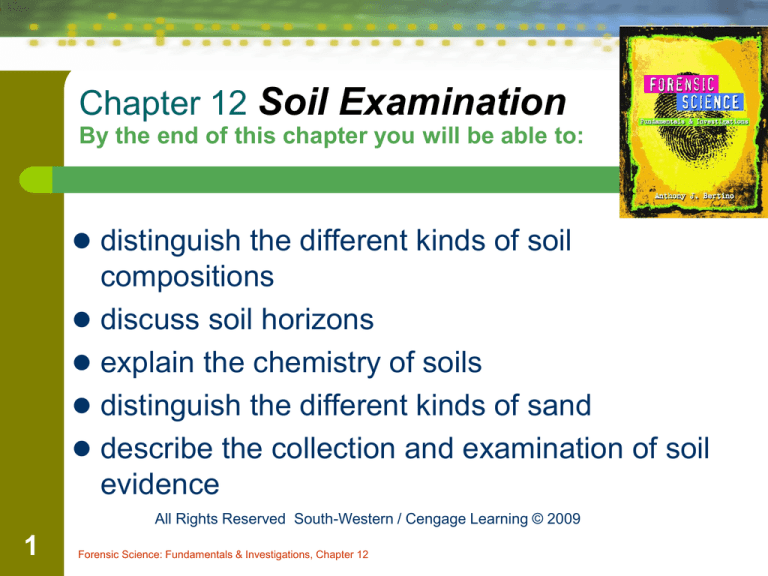
Chapter 12 Soil Examination
By the end of this chapter you will be able to:
distinguish the different kinds of soil
compositions
discuss soil horizons
explain the chemistry of soils
distinguish the different kinds of sand
describe the collection and examination of soil
evidence
All Rights Reserved South-Western / Cengage Learning © 2009
1
Forensic Science: Fundamentals & Investigations, Chapter 12
Introduction
Factors such as temperature, rainfall, and the
chemicals and minerals in the soil influence
the production of soil.
Soil from different locations can have different
physical and chemical characteristics.
Because of this, soil analysis has been helpful
in such things as linking suspects to crime
scenes and locating burial sites.
2
Forensic Science: Fundamentals & Investigations, Chapter 12
History of Forensic Soil
Examination
Dr. Hans Gross is believed to be one of the first
to recognize the importance of physical
evidence.
His Criminal Investigation, written in 1893, had
ground breaking material in this science.
Georg Popp is credited with being the first to use
soil evidence to solve a crime.
He linked soil samples found on a suspect with
samples found at the crime scene.
3
Forensic Science: Fundamentals & Investigations, Chapter 12
Soil Composition
Soil is part of the top layer of Earth’s crust.
It contains minerals, decaying organisms,
water, and air in varying amounts.
Soil texture describes the size of the mineral
particles that make up soil.
The 3 main grain sizes are sand, silt, and
clay.
The 3 subcategories of soil are loam, peat,
and chalk.
4
Forensic Science: Fundamentals & Investigations, Chapter 12
Soil Profiles
Soils are formed in layers (horizons):
5
Humus, the O horizon, is made of decaying organic
matter.
Topsoil, the A horizon, is a mixture of humus and
minerals.
Sand and silt makes up the E horizon.
Subsoil, the B horizon, is made of clay and minerals.
Broken rock, the C horizon, has very little humus
present.
Solid rock makes up the R horizon.
Forensic Science: Fundamentals & Investigations, Chapter 12
Chemistry of the Soil
The pH scale shows how acidic or basic something is.
6
Forensic Science: Fundamentals & Investigations, Chapter 12
Chemistry of the Soil
An important chemical property of soil is whether it is
acidic or basic (alkaline).
Materials that make up a soil are not the only factors
that affect its pH level.
–
Rainfall can change the pH value of a soil.
–
Pollution and fertilizer also can change the pH
value of soil.
The pH value of a soil sample can help a forensic
scientist match it to other samples.
7
Forensic Science: Fundamentals & Investigations, Chapter 12
Sand
8
The action of wind and water on rocks forms
sand.
This may take millions of years.
Because water acts as a buffer, water
produces sand more slowly than wind.
Wind-blown sand becomes rounded more
quickly because the grains strike each other
directly without a buffer.
Forensic Science: Fundamentals & Investigations, Chapter 12
Mineral Composition of Sand
Sand from different locations contains different
combinations of minerals.
The most common mineral found in sand is
quartz.
Other minerals may be present in smaller
quantities.
Grains of sand can be rounded or angular
depending on the amount of weathering and the
mineral composition of the grains.
9
Forensic Science: Fundamentals & Investigations, Chapter 12
Mineral Composition of Sand
Other than quartz, mineral content of sand
can include:
– feldspars
– micas
– iron compounds
Sand also can be made of organic material
such as coral and seashells.
The following 2 slides show the 4 basic
sources of sand.
10
Forensic Science: Fundamentals & Investigations, Chapter 12
Mineral Composition of Sand
—Continental and Volcanic Sand
Note that the identifying feature of continental sand
is quartz; whereas there is no quartz in volcanic
sand.
11
Forensic Science: Fundamentals & Investigations, Chapter 12
Mineral Composition of Sand
—Skeletal and Precipitate Sand
Skeletal sand gives off bubbles when mixed with an
acid. Oolite formation is not a result of weathering
but an example of depositions.
12
Forensic Science: Fundamentals & Investigations, Chapter 12
Soil
Collection
13
In order to present credible evidence in court, a chain
of custody log is essential.
1. A person bags the evidence, marks it for identification,
seals it, and signs it across the sealed edge (above, left).
2. It is signed over to a technician in a lab for analysis who
opens it, but not on the sealed edge.
3. After analysis, the technician puts it back into the evidence
bag, seals it in another bag, and signs the evidence log
(above, right).
Forensic Science: Fundamentals & Investigations, Chapter 12
Soil Examination
The presence of soil unique to a certain area can
show that a suspect or victim must have been in that
area.
Layers of soil or sand taken from shoes or the wheels
of vehicles can show a suspect was present at a
series of locations.
Explain how each of the following is useful in the
examination of soil samples:
A. looking at samples macroscopically
B. X-ray diffraction
14
Forensic Science: Fundamentals & Investigations, Chapter 12
. . . . . . . . . . . . . . . . . Summary
There are 3 grain sizes and 3 subcategories of
15
soil.
Soil forms in horizons.
The pH scale measures how acidic or alkaline
different soils are.
Sand is formed by the action of wind and water.
If investigators follow good collection procedures,
they can analyze samples to see if a suspect was
at a crime scene.
Forensic Science: Fundamentals & Investigations, Chapter 12









